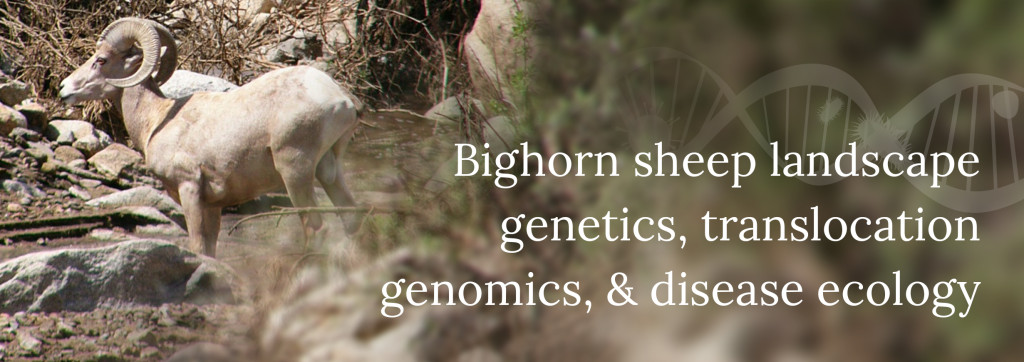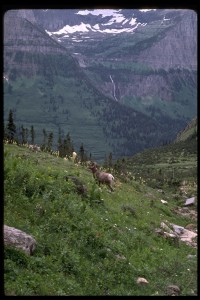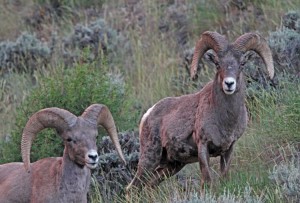Bighorn Sheep
Bighorn Sheep

Lab researchers: Sierra Love Stowell, Holly Ernest
 Wyoming bighorn sheep
Wyoming bighorn sheep
Bighorn sheep throughout western North America suffer from disease outbreaks, habitat degradation and loss, and resulting worsening of problems of small population sizes, sometimes including increased population impacts by predation and other causes of mortality. Small population sizes lead to high risk of inbreeding and reduced genetic diversity, and sometimes, individual population extinction. Until now, there has been no comprehensive state-wide genetic assessment of Wyoming’s bighorn sheep herds. Without such foundation, therefore no good way to track changes in genetic diversity, herd structure, and effective population sizes going into the future. Our lab is aiming to solve this problem and add vital information for bighorn sheep conservation.
Our lab is working to provide this vital information over the next several years. State-of-the art next generation genome sequencing tools are being employed with previous genetic methods to genetically test hundreds of bighorn sheep samples. These analyses aim to 1) identify genetically interbreeding populations statewide of bighorn sheep in Wyoming; 2) determine translocation genomics (genetic signatures of past translocation events and how those historic translocations contributes to current genetics of each herd); 3) assess gene flow among herds; genetics of migration and dispersal; 4) evaluate herd-specific genetic diversity; 5) estimate genetic effective population sizes for each herd (numbers of individuals contributing to gene pool); 6) test population assignment of specific individual bighorn sheep (for example to identify source population of individual dispersing rams found near domestic sheep); 7) provide genetic determination of sizes of “populations at risk” for epidemiology of disease threats to bighorn sheep in Wyoming (pneumonia pathogens, EHD-Blue tongue, as examples; to estimate disease prevalence, the size of the population at risk is needed as a denominator when number of sick bighorn sheep is the numerator – genetics can help provide this index); 8) develop better tools and reference data sets for use in forensic analysis (for example, poaching cases by the WGFD Forensic lab). These data will form a foundation with which wildlife agencies, including Wyoming Game and Fish Department (WGFD), can monitor the genetic health of Wyoming’s herds into the future. Also included in our analyses are genetic comparisons with our Desert Bighorn Sheep genetics data – see below.
Our collaborators include the Wyoming Game and Fish Department, the Wyoming Bighorn Sheep Working Group, and Montana State University, and funding comes from multiple sources including the Wyoming Wild Sheep Foundation and the Wyoming Governors’ Big Game Grant.
Desert bighorn sheep
Our research group (UC Davis and newly University of Wyoming) has conducted research, education, and service toward health and population genetics of Desert and Sierra Nevada Bighorn Sheep for past twenty years. A few of the highlights of our work are listed below.
- California-Mexico Transborder Bighorn Sheep Conservation Genetics Project (completed 2014). Genetics of migration: Transborder (California-Mexico) assessment of gene flow for Peninsular Bighorn sheep (federally listed endangered). This research detected important migratory pathways across the Mexico-California border that provide vital gene flow (fresh genetic material) between bighorn populations in the two countries. The region of the main migration corridor has proposals for large energy and other developments. Now with this information, mitigation measures can be enacted to protect this migration pathway and the conservation of this federally listed endangered bighorn sheep population. This work was conducted in collaboration with The Nature Conservancy, the San Diego Zoo, California Department of Fish and Wildlife, and collaborators in Mexico. Funding came from The Nature Conservancy. Genetic population structure of Peninsular bighorn sheep (Ovis canadensis nelsoni) indicates substantial gene flow across US-Mexico border. Michael Buchalski, Asako Navarro, Walter Boyce, T. Winston Vickers, Mathias Tobler, Lisa Nordstrom, Jorge Alaníz García, Daphne Gille, Maria Cecilia Penedo, Oliver Ryder, Holly Ernest. 2015. Biological Conservation. 184:218 International collaboration among Ernest lab members Mike Buchalski, Daphne Gille; UCD Wildlife Health Center Walter Boyce, Winston Vickers, Holly Ernest; Veterinary Genetics Lab Cecilia Penedo, San Diego Zoo Asako Navarro, Mathias Tobler, Lisa Nordstrom, Oliver Ryder; and biologists and veterinarians in Mexico including Jorge Alaníz García. dx.doi.org/10.1016/j.biocon.2015.01.006
- Rangewide Desert Bighorn Sheep genetic analysis completed in 2016 determined that desert subspecies represent ancient lineages likely descended from separate Pleistocene refugial populations and should therefore be managed as distinct taxa to preserve maximal biodiversity. This work provides valuable information to guide conservation and management.
- Arizona Bighorn Sheep Landscape Genetics Project – Completed 2014 and in-preparation for publication. Daphne Gille, Holly Ernest, and collaborators. Collaboration and funding through Arizona Game and Fish Department and Arizona Desert Bighorn Sheep Society.
- Epidemiologic investigation of a large bighorn sheep die-off in the Mojave Desert: Desert bighorn sheep mortality due to presumptive type C botulism. Swift, P.K., J.D. Wehausen, H.B. Ernest, R.S. Singer, A.M. Pauli, H. Kinde, T.E. Rocke, and V.C. Bleich. 2000. Journal of Wildlife Diseases. 36(1):184-189.
Bighorn Sheep Disease Ecology and Population Genetics Publications from our lab
- Bighorn sheep genetic structure in Wyoming reflects geography and management. 2020. Sierra M. Love Stowell, Roderick (Erick) B. Gagne, Doug McWhirter, W. Hank Edwards, Holly B. Ernest. Journal of Wildlife Management. Broad collaboration among institutions and agencies including University of Wyoming, Wyoming Department of Game and Fish, Wyoming Wild Sheep Foundation, the national Wild Sheep Foundation, Colorado State University, and others.
- Genetic Outcomes of Translocation of Bighorn Sheep in Arizona. 2019, Journal of Wildlife Management. Daphne A. Gille, Michael R. Buchalski, Dave Conrad, Esther S. Rubin, Amber Munig, Brian F. Wakeling, Clinton W. Epps, Tyler G. Creech, Rachel Crowhurst, Brandon Holton, Ryan Monello, Walter M. Boyce, M. C. T. Penedo, Holly B. Ernest. Broad collaboration among institutions and agencies including Arizona Dept. of Game and Fish, Department Of Fisheries And Wildlife, Oregon State University, Nevada Division of Wildlife, National Park Service, Wildlife Health Center and Veterinary Genetics Laboratory at University of California Davis, Wildlife Genetics Research Laboratory at California Department Of Fish And Wildlife, and Center For Large Landscape Conservation in Bozeman, MT.
- Phylogeographic and population genetic structure of bighorn sheep (Ovis canadensis) in North American deserts. 2016. Michael R. Buchalski; Benjamin N. Sacks; Daphne A. Gille; Maria Cecilia T. Penedo; Holly B. Ernest; Scott A. Morrison; Walter M. Boyce. Journal of Mammalogy. doi: 10.1093/jmammal/gyw011
- Genetic population structure of Peninsular bighorn sheep (Ovis canadensis nelsoni) indicates substantial gene flow across US-Mexico border. Michael Buchalski, Asako Navarro, Walter Boyce, T. Winston Vickers, Mathias Tobler, Lisa Nordstrom, Jorge Alaníz García, Daphne Gille, Maria Cecilia Penedo, Oliver Ryder, Holly Ernest. 2015. Biological Conservation. 184:218 International collaboration among Ernest lab members; Veterinary Genetics Lab, San Diego Zoo; and biologists and veterinarians in Mexico. dx.doi.org/10.1016/j.biocon.2015.01.006
- Fecal DNA analysis and risk assessment of mountain lion predation of bighorn sheep. Ernest H.B., E.S. Rubin, W.M. Boyce. 2002. Journal of Wildlife Management 66(1) 75-85.
- Captive breeding Contingency plan: A Guide for Captive Breeding of Sierra Nevada Bighorn Sheep. Ernest HB. 2001. Report for Interagency Agreement # P9980059 between California Department of Fish and Game and Wildlife Health Center, School of Veterinary Medicine, University of California, Davis CA. 147 pages.
- Desert bighorn sheep mortality due to presumptive type C botulism. Swift, P.K., J.D. Wehausen, H.B. Ernest, R.S. Singer, A.M. Pauli, H. Kinde, T.E. Rocke, and V.C. Bleich. 2000. Journal of Wildlife Diseases. 36(1):184-189.


